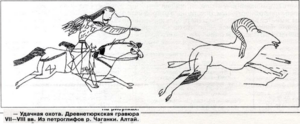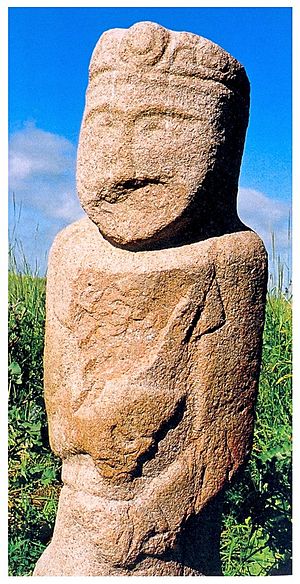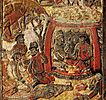Göktürks facts for kids
| 𐱅𐰇𐰼𐰰:𐰉𐰆𐰑𐰣 Türük Bodun |
|
|---|---|

Göktürk petroglyphs from modern Mongolia (6th to 8th century).
|
|
| Total population | |
| Ancestral to some Turkic populations | |
| Regions with significant populations | |
| Central and Eastern Asia | |
| Languages | |
| Old Turkic | |
| Religion | |
| Tengrism | |
| Related ethnic groups | |
| Türgesh, Toquz Oghuz, Yenisei Kyrgyz, Xueyantuo, Shatuo |
The Göktürks were a group of Turkic peoples who lived in Inner Asia during the Middle Ages. They were also known as Türks, Celestial Turks, or Blue Turks. Under the leadership of Bumin Qaghan and his sons, the Göktürks became very powerful. They took over from the Rouran Khaganate and created the First Turkic Khaganate. This was an important empire that helped shape the culture and beliefs of many Turkic groups in the future.
Contents
What Does "Göktürk" Mean?
The name "Göktürk" comes from a misunderstanding of the word "Kök." The ruling family of the Göktürks was called the Ashina. Their own name for themselves was "Türük" or "Kök Türük." The word Türk likely means 'created' or 'born' in the Old Turkic language.
In ancient Chinese writings, the Göktürks were called Tūjué. Some sources say this name meant "combat helmet". This was supposedly because the Altai Mountains, where they lived, looked like a helmet.
The name "Göktürk" is often translated as "Celestial Turk" or "Blue Turk." This is because the color blue was linked to the sky and heavenly powers. The Göktürks believed their rulers were chosen by the sky god. The name of their ruling clan, Ashina, might also mean "deep blue."
The word Türk was used by the Göktürks only for themselves and the people they ruled. They did not call other Turkic-speaking groups like the Uyghurs or Kyrgyz "Türks." Over time, as the Turkic empires grew, the name "Turk" began to include all the people who were part of these empires.
History of the Göktürks
Where Did They Come From?
The Göktürk rulers belonged to the Ashina clan. We first hear about them in 439 CE. At that time, 500 Ashina families moved northwest to the Rouran Khaganate near Gaochang.
For many years, the Göktürks lived north of the Altai Mountains. They were skilled at working with metals for the Rouran Khaganate. Some historians believe that the Ashina clan's rise to power was more like a change from within the Rouran Khaganate, rather than an outside attack.
The early Göktürk people were a mix of different groups. Some of their leaders' names were not even Turkic. However, no matter what language they spoke originally, the Ashina and the people they ruled eventually all spoke Turkic languages. This helped them create a shared culture.
How the Empire Grew
The Göktürk empire became very strong in the late 6th century. They started to attack the Sui dynasty in China. However, a civil war broke out among the Göktürk nobles over who should be the next leader. With help from the Chinese Emperor Wen of Sui, Yami Qaghan won. But the Göktürk empire split into two parts: the Eastern and Western empires.
After the civil war, Yami Qaghan became loyal to the Sui dynasty. When the Sui dynasty started to weaken, Shibi Khagan attacked their land. He even surrounded the Chinese Emperor Yang of Sui with 100,000 horsemen in 615 AD. After the Sui dynasty fell, the Göktürks got involved in China's civil wars. They supported a rebel leader against the rising Tang dynasty.
Conquest by the Tang Dynasty
Even though the Göktürks had helped the Tang dynasty early on, conflicts soon began. The Göktürks attacked the northern borders of the Tang Empire. They even marched their main army of 100,000 soldiers to Chang'an, the Tang capital. The brave Emperor Taizong of Tang managed to make them turn back.
Four years later, Emperor Taizong sent his own troops to Mongolia. They defeated the main Göktürk army in the Battle of Yinshan and captured their leader, Illig Qaghan, in 630 AD. This meant the Tang dynasty took control of the Mongolian Plateau, and the Eastern Turks became part of China.
Emperor Taizong decided to forgive the Göktürk nobles and offered them jobs as imperial guards. However, some Göktürks, led by Ashina Jiesheshuai, tried to assassinate the emperor in 639 CE. They failed and were killed. After this, Emperor Taizong moved many settled Turkic people north of the Yellow River. But many Göktürk generals remained loyal to the Tang Empire.

The Göktürk Revival
In 679 CE, some Turkic leaders, Ashide Wenfu and Ashide Fengzhi, rebelled against the Tang dynasty. They declared Ashina Nishufu as their new leader. Although this rebellion was put down, another one started in 682 CE. Ilterish Qaghan and Tonyukuk led this new revolt and took control of a castle.
This marked the start of the Second Turkic Khaganate. The Göktürks got involved in wars between the Tang and Khitan tribes. However, after the death of their leader Bilge Qaghan, the Göktürks struggled to control other Turkic tribes. In 744 CE, the Uyghur Khaganate, with help from the Tang dynasty, defeated the last Göktürk Khaganate. The Uyghurs then took control of the Mongolian Plateau.
Göktürk Rulers
The Ashina tribe of the Göktürks ruled several empires. These included the First Turkic Khaganate, which later split into the Eastern Turkic Khaganate and the Western Turkic Khaganate. Later, they formed the Second Turkic Khaganate. These empires controlled large parts of Central Asia and the Mongolian Plateau from 552 to 745 CE. Their rulers were called "Khagan" (Qaghan).
Göktürk Religion
The Göktürks had a religion where they believed in one main god, but also many other gods or spirits. Their most important god was the sky god, Tengri. They believed Tengri gave them good fortune and watched over the world's order. People would pray to Tengri and offer sacrifices, often a white horse. The ruler was believed to get his power from Tengri.
Many other powers were also important. These included the Earth, Mountains, Water, Springs, and Rivers. They also honored trees, fire (a symbol of family), stars (like the sun and moon), and a mother goddess named Umay. Heroes and ancestors were also respected. These powers were believed to become stronger when many of them were together, like many trees forming a forest.
Göktürk Genetics
Scientists have studied the DNA of ancient Göktürk soldiers and leaders. These studies help us understand where the Göktürk people came from.
One study in 2018 looked at the remains of four elite Göktürk soldiers. Their DNA showed a mix of East Asian and European ancestry. This suggests that the Göktürks had contact with people from Europe. Later Turkic groups in Central Asia showed even more East Asian ancestry. This means that the spread of Turkic culture in Central Asia was often led by smaller groups of East Asian origin.
A 2020 study looked at DNA from seven early medieval Göktürk remains in Mongolia. It found that these Göktürks had about 40% West Eurasian (European/Central Asian) ancestry and 60% East Eurasian ancestry. The West Eurasian ancestry seemed to come more from male ancestors. This suggests that men from West Eurasia joined the Göktürk groups.
A 2023 study focused on the DNA of Empress Ashina, a royal Göktürk. Her DNA was mostly of Ancient Northeast Asian origin (about 96-98%). This study suggests that the royal Ashina family and the Göktürk Khaganate likely came from Northeast Asia. However, the study also noted that other Göktürks from the steppe had a mix of West Eurasian ancestry. This shows that the Göktürk empire was made up of different groups of people.
These findings suggest that Turkic languages and culture spread more through ideas and cultural exchange (cultural diffusion) rather than just large groups of people moving (demic diffusion).
Gallery
See also
 In Spanish: Köktürk para niños
In Spanish: Köktürk para niños
- Göktürk family tree
- Horses in East Asian warfare
- Khazars
- Timeline of the Turkic peoples (500–1300)
- Silver Deer of Bilge Khan










